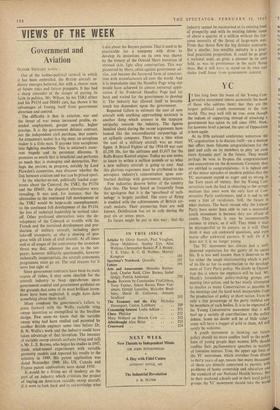VIEWS OF THE WEEK
Government and Aviation
OLIVER STEWART writes :
Out of the techno-political turmoil in which it has been embroiled, the British aircraft in- dustry emerges battered, but with a clearer view of future risks and future prospects. It has had a sharp reminder of the danger of putting its faith in politics. Mr. Wilson, by his TSR2 dither and his P1154 and HS681 cuts, has shown it the advantages of freeing itself from government direction and control.
The difficulty is that in aviation, war and the threat of war mean increased profits, ex- tended employment, greater security, higher prestige. It is the government defence contract, ,not the independent civil purchase, that counts. An armaments maker is a big man; an aeroplane maker is a little man. It paysito turn aeroplanes into fighting machines. This is aviation's recur- rent tragedy and its persistent dilemma. It promises so much that is beneficial and performs so much that is damaging and 'destructive. Per- haps the reviews in progress, notably by Lord Plowden's committee, may discover whether the link between aviation and war can be prised apart.
In the whether-or-not, politically loaded argu- ments about the Concord, the TSR2, the P1154 and the HS681, the disputed alternatives were revealing. It was said, for instance, that the alternative to the continued full development of the TSR2 would be large-scale unemployment; to the continued full development of the P1154, the loss of technical leadership in vertical take- off. Other professed alternatives were the de- velopment of the Concord or trouble with the French and the sustained development and pro- duction of military aircraft, including short take-off transports, or else a slowing of pro- gress with all kinds of civil aircraft. At all times and at all stages of the controversy the unspoken threat was that, whatever the cost to the tax- payer, however militarily questionable, however technically inappropriate, the aircraft armaments programme must go on. The real reasons for it were lost sight of.
Since government contracts have been its main source of riches, it may seem churlish for the aircraft industry to heap opprobrium upon government control and government guidance on the grounds that some of its most brilliant inven- tions have been neglected. It might have done something about them itself.
Many condemn the government's failure to press forward with the Wallis variable wing sweep invention as exemplified in the Swallow design. Few seem to know that the variable sweep wing had been studied and patented by another British engineer some time before Dr. B. N. Wallis's work and the industry could have taken advantage of that invention. The inventor of variable sweep aircraft surfaces (wing and tail) is Mr. L. E. Baynes, who began his studies in 1947, made wind-tunnel experiments with variable geometry models and reported his results to the ministry in 1949. His patent application was dated Novemirr 1949. His US, Canada and France patent applications were dated 1950. It would be a fitting act of modesty on the part of an industry which criticises the project of buying an American variable sweep aircraft, if it were to look back and to acknowledge what it did about the Baynes patents. That it used to be practicable for a company with drive to develop its inventions on its own was shown by the history of the Oswald Short invention of stressed skin, light alloy construction. This was' pioneered by Short, often against government ad- vice, and became the favoured form of consteuc- tion with manufacturers all over the world. And, it is improbable that the Handley Page wing slot would have achieved its almost universal appli- cation if Sir Frederick Handley Page had sat back and waited for the government to develop it. The industry has allowed itself to become much too dependent upon the government.
Repeated failure to estimate the cost of new aircraft with anything approaching accuracy is another thing which arouses in the taxpayer antipathy towards the industry. The figures bandied about during the recent arguments have looked like the uncoordinated outpourings of an epileptic computer. There was a time when the cost of a military aircraft was an exact figure. A Bristol Fighter of the 1914-18 war cost £1,350 10s. for the airframe and £1,617 for the Rolls-Royce Kestrel engine. Today no one seems to know to within a million pounds or so what a new military aircraft is going to cost. And this glorious vagueness must be attributed to the aerospace industry's concentration upon con- tractual dealings with government departments.
Few industries deserve better of the country than this. The boast heard so frequently from the apologists that it is the 'spearhead of tech- nology' is largely justified. The story of flying is studded with the achievements of British air- craft makers. Their pioneering feats are well known. Debilitation has set in only during the past six or seven years.
Its future might be put in this way: that the
Industry cannot be maintained at its existing level of prosperity and with its existing labour force of about a quarter of a million without the. tire- some necessity of the threat of large-scale war. From that threat flow the big defence contracts. But o smaller, less wealthy industry is a prac- tical peacetime proposition. It could be as great a national asset, as great a pioneer in its own field, as was its predecessor in the early flying days. But it will have to stand on its own and shake itself loose from government control.

































 Previous page
Previous page